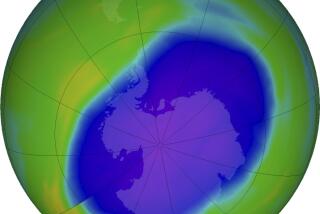Ozone Issue Expert Says Don’t Wait to Ban CFCs
- Share via
One of the two scientists who discovered the chemical depletion of the Earth’s ozone shield while conducting research at UC Irvine in the 1970s on Friday praised President George Bush’s call for a ban on the destructive compounds that cause the problem, but said action should not wait until the year 2000.
Mario Molina, now a researcher at the Jet Propulsion Laboratory in La Canada Flintridge, sounded the first alarm in 1974 along with UCI chemistry professor F. Sherwood Rowland. Recently, Molina proved that chemical chlorofluorocarbons, known as CFCs, in the atmosphere are directly responsible for an irreparable hole in the ozone over Antarctica.
“I’m extremely pleased that it (White House attention to the danger posed by CFCs) is happening,” Molina said Friday.
“Of course, we would like to see a complete ban imposed as soon as possible. The damage occurring to the ozone now is the result of CFCs released a decade ago, and the CFCs released today will damage the ozone for 100 years,” he said. “The problem will get worse no matter what, so the sooner we act, the better.”
Nevertheless, Molina said, Bush’s statement and increased world attention to the problem “is reassuring that one can make a difference; one just has to do it right.”
Molina, 42, was a postdoctoral researcher at UCI when he and Rowland discovered that CFCs, substances found in aerosol sprays, air-conditioning systems and cleaning solvents, caused chain reactions responsible for rapid destruction of the ozone.
Rowland, who for many years was derided as a crackpot and a publicity hound by CFC manufacturers, was vindicated last month when he received the Japan Prize for his work. The award, which includes a $400,000 cash prize, is considered second in scientific prestige only to the Nobel Prize.
Rowland was in London, where he is scheduled to address a United Kingdom Department of Environment Symposium on saving the ozone layer this weekend, and could not be reached for comment Friday.
However, at a reception in his honor after the prize announcement in February, Rowland, 62, said the recent discovery by Japan’s biggest CFC manufacturer of a promising replacement compound could speed elimination of CFCs.
“The problem on a global basis now has a life of its own,” he said. “Solutions are being sought by many governments and the United Nations, and changes are being made. . . . The direction in which things are looking is (toward) a worldwide ban within 15 years.”
The ozone layer is a protective band of gas that blocks much of the sun’s ultraviolet rays, protecting animals and plants. Rowland and Molina have predicted that depletion of the ozone would result in increased skin cancer rates and catastrophic climatic changes. Rowland’s work to publicize the findings resulted in a 1978 congressional ban on the use of CFCs in aerosol sprays.
In hindsight, Molina said, “Society should have started much sooner to look for replacements.
“We had to move through a lot of hurdles to convince society in general that this was a problem. Looking at it most optimistically, things could have been a lot worse if we had not issued these initial warnings.”
UCI research associate Donald Blake, who is in charge of Rowland’s atmospheric research group, said Friday that there is wide agreement among environmentalists that the 1987 Montreal Protocol, an international pact to cut CFC production in half, did not go far enough.
“There is no longer skepticism about this problem,” Blake said. “It was discovery of ozone hole (above Antarctica) that really brought this to people’s attention. There is recognition of the effect actions of our generation will have on many generations in the future.”





